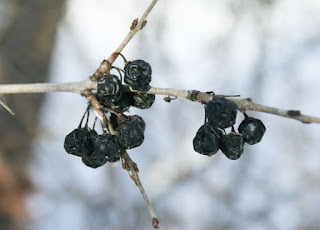 |
| The twining stems, yellow capsules and scarlet arils of Oriental Bittersweet are distinctive in winter. |
Winter is an ideal time to look for Oriental bittersweet (Celastrus orbiculatus), an invasive vine that is spreading in Minnesota. Left unchecked, this aggressive vine can smother and strangle its hosts and shade out native vegetation. For those reasons, Oriental bittersweet is considered a noxious weed in several states, including Minnesota. The state’s Department of Agriculture includes it on the Prohibited-Eradicate list, which means all above- and below-ground parts should be destroyed.
What to Look For
Like native American bittersweet (C. scandens),
Oriental Bittersweet, also called Asian Bittersweet, is a twining vine. Oriental Bittersweet vines are often tightly wrapped around their hosts, sometimes girdling them, whereas American Bittersweet vines are usually looser. In both species, buds are mound-shaped, 3-5 mm long (about an eight of an inch) and pointed at right angles to the stem. As the stems age they develop ridges
and furrows in irregular diamond-shaped or striped patterns. Vines are either male (pollen-producing) or female (fruit-producing).
 |
| Clockwise from top left: A bud, tightly wrapping vine, and mature bark of Oriental Bittersweet. |
In contrast, American bittersweet
capsules are orange with darker arils. The
capsules may fade to tan during winter, but typically they retain at least a few specks of orange. Fruit clusters grow at the ends of stems and branches rather than from the axils.
 |
| Fruits of Oriental Bittersweet (left) and American Bittersweet (right). |
Hybrids Can Have Intermediate Characteristics
Hybrids of Oriental and American Bittersweet are uncommon, but of the few that have been found, at least one displayed intermediate characteristics. A hybrid female identified during one field study produced clusters of flowers and fruits both at the ends of the stems and at the axils. Its capsules were light orange, intermediate between the yellow of Oriental Bittersweet and the darker orange of American Bittersweet. More information about hybrid research follows the references below.Where to Look
Oriental Bittersweet grows in a variety of conditions. Typical habitats include fields, forest edges, and open woods, but
even forest interiors can support this shade-tolerant vine. Removing Oriental Bittersweet from residential properties is as important as removing it from
natural areas, because birds can spread the seeds wherever they fly.
How to Manage Oriental Bittersweet
Managing Oriental Bittersweet typically involves applying herbicides to the basal (lower) bark, leaves or cut stems. Seedlings can be hand-pulled, but they're hard to identify at that stage. Most of the references below include management advice.
References
Oriental
bittersweet. EDDMapS. Website accessed November 5, 2022.
Oriental
bittersweet. Minnesota Department of Agriculture. Website accessed November 5, 2022.
Oriental
bittersweet. Minnesota Department of Natural Resources. Website accessed November 5, 2022.
Asian Bittersweet. Woody Invasives of the Great Lakes Collaborative. Website
accessed January 29, 2021.
Research on Hybrids
Hybridization between Oriental and American Bittersweet is suspected
of contributing to the decline of the native species. One study (Pooler et al.
2002) found that crossing male Oriental Bittersweet with female American Bittersweet produced seeds that germinated sooner (with shorter dormancy) and
seedlings that grew faster than American Bittersweet. Although these results
hint at possible dominance of the hybrid vines, the study did not follow the
hybrids into maturity.
A later study (Zaya et al. 2015) looked for naturally occurring
hybrids across the eastern half of the U.S. to determine their prevalence and
their potential impact on American Bittersweet. Using DNA analysis, the
researchers found that 4-8% of 475 individuals sampled were hybrids. Only one
female hybrid was confirmed among the sampled vines, and it displayed
intermediate field characteristics. Flower clusters were produced both at the
ends of stems and from the axils, and capsule color was light orange,
intermediate between the yellow of Oriental Bittersweet and the darker orange
of American Bittersweet. The hybrid capsules were smaller than either parent
and produced few or no viable seeds.
Two male hybrid vines were also confirmed among the vines
sampled. When researchers examined their pollen grains, they found that more
than 90% of them were smaller than the average for either parent, so they were
judged to be inviable. Like the female hybrid, the male hybrids in this study
could not reproduce as successfully as their parents.
The 2015 research suggests that the harm to American Bittersweet caused by hybridization isn’t from the hybrids themselves. Unlike some
crosses between native and introduced species, hybrids of American and Oriental Bittersweet appear to be uncommon, and they do not
successfully reproduce to form aggressive populations. Instead, the harm
comes from wasting the reproductive potential of female American Bittersweet
vines. All the hybrids identified in the 2015 study resulted from Oriental Bittersweet pollen fertilizing American Bittersweet eggs. Because female flowers so pollinated could not then accept pollen
from a male American bittersweet, they were not able to produce seeds that could
maintain the native population.
References:
Pooler, MR, Dix, RL, and J Feely. 2002. Interspecific hybridizations between the native bittersweet, Celastrus scandens, and the introduced invasive species, C. orbiculatus. Southeastern Naturalist 1(1): 69-77.









